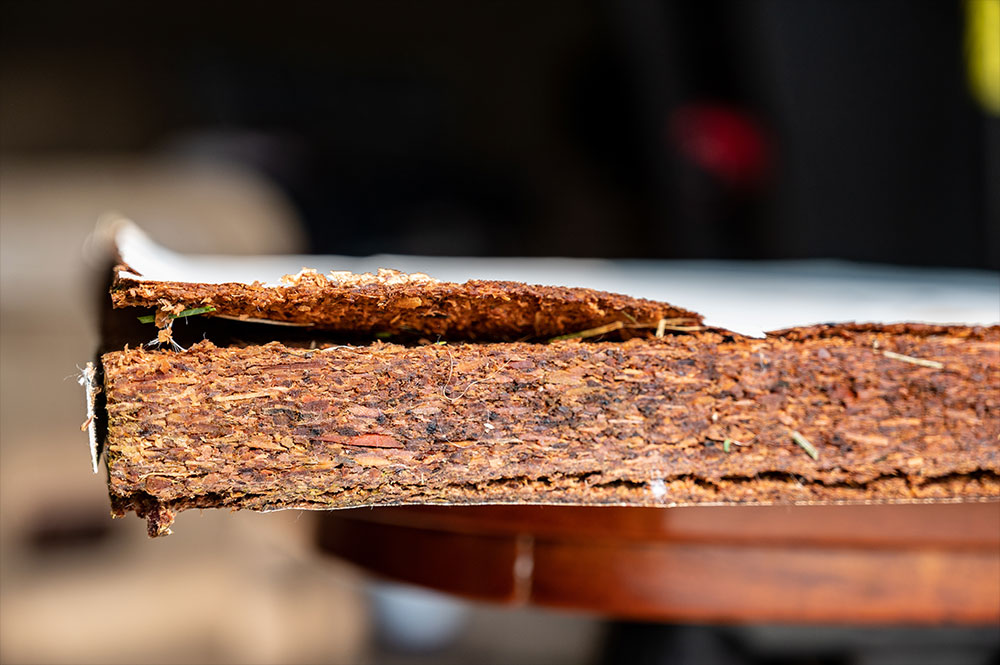Dealing with water-damaged swollen wooden furniture can be daunting. Whether from spills, humidity, or flooding, water can cause wood to swell, discolour, and deteriorate. As a rubbish removal expert, I have seen many pieces of furniture damaged by water. Here are professional insights and steps on how to restore swollen wood furniture to its former glory or make an informed decision when it’s time to let go.

Understanding Water Damage
Types of Water Damage
Water damage can vary in severity, from surface stains to deep structural issues. The type of damage can influence the repair approach:
- Surface Water Damage: This usually results from spills or brief water exposure, which may cause minor swelling and staining.
- In-depth Water Damage: Occurs due to prolonged exposure to water, like in flooding, causing significant swelling, warping, and structural damage.
Assessing the Damage
Before attempting any repairs, it’s crucial to assess the extent of the damage. Check for signs of structural weakness, significant warping, or mould. If the damage is superficial, it’s often repairable. However, extensive damage might not be worth the effort and cost of repair.
DIY Repairs for Water-Damaged Swollen Wooden Furniture
Drying Out the Furniture
Remove Excess Moisture
Gently blot the surface with a clean, dry cloth to remove as much moisture as possible. Avoid rubbing the surface to prevent further damage.
Air Dry
Place the furniture in a well-ventilated area away from direct sunlight. Use fans to circulate air around the piece, which helps to evenly dry it out. This process can take several days to weeks, depending on the extent of the damage.
Reducing Swelling
Use a Dehumidifier
In a humid environment, using a dehumidifier can help pull moisture out of the wood, reducing swelling more effectively.
Apply Weight
For slightly warped areas, applying weight can help flatten the wood back into shape as it dries. Ensure the weights are evenly distributed and the surface underneath is protected to avoid further damage.
Repairing the Finish
Sanding
Once the wood is thoroughly dried, lightly sand the swollen areas with fine-grit sandpaper to smooth out any raised grains or rough spots. Always sand along the grain to prevent scratches.
Refinishing
After sanding, you may need to refinish the piece to match its original look. Apply a matching stain or paint, followed by a protective coat of varnish or lacquer to seal the wood and protect it from future damage.
Preventing Future Water Damage
Protective Measures
Use Coasters and Pads
The simple habit of using coasters can significantly extend the life of your wood furniture. Beverages, whether hot or cold, can create condensation or spills that seep into the wood, causing unsightly rings and eventual swelling. By using coasters, you create a protective barrier that prevents moisture from directly contacting the wood surface. Similarly, placing pads under plant pots is equally important. Plant pots can leak excess water or retain humidity at the base, which can seep into the furniture and cause water damage over time. Opt for waterproof or highly absorbent coasters and pads that ensure that no moisture reaches the wood.
Maintain Humidity Levels
Controlling the humidity in your home is crucial for preserving wood furniture. Wood is hygroscopic, meaning it naturally absorbs and releases moisture depending on the humidity in the air. Excessive humidity can cause wood to swell, while too little can lead to drying and cracking.
Aim to maintain indoor humidity levels between 30% and 50% to create a stable environment for your wood furnishings. Use humidifiers or dehumidifiers as necessary, depending on the climate and season. Additionally, avoid placing furniture near air vents or radiators as these can create localised dry zones or moisture-rich areas, exacerbating the problem.
Regular Maintenance
Regular maintenance is key to preventing water damage and extending the durability of your wood furniture. Periodic checks for signs of wear or damage can help catch issues before they escalate. Applying a wood conditioner or oil can make a significant difference.
These products add moisture to the wood, replenishing its natural oils lost over time due to exposure and cleaning. They also form a protective seal that minimises the wood’s exposure to ambient moisture. This routine maintenance not only enhances the appearance of your furniture but also increases its resistance to water damage, ensuring that your wood pieces remain beautiful and functional for years to come.
Conclusion: When to Call a Professional
While many instances of water damage can be remedied with DIY efforts, some cases may be beyond repair, especially when there is severe structural damage or mould growth. If your furniture is extensively damaged and not worth the repair cost, consider removing it responsibly.
At King Gong Rubbish Removal, we can help you dispose of any old and damaged furniture. We will collect your unusable furniture pieces and take them to the local tip, ensuring your home remains clutter-free and safe. Trust in our expertise to handle your furniture removal needs efficiently and environmentally responsibly.
